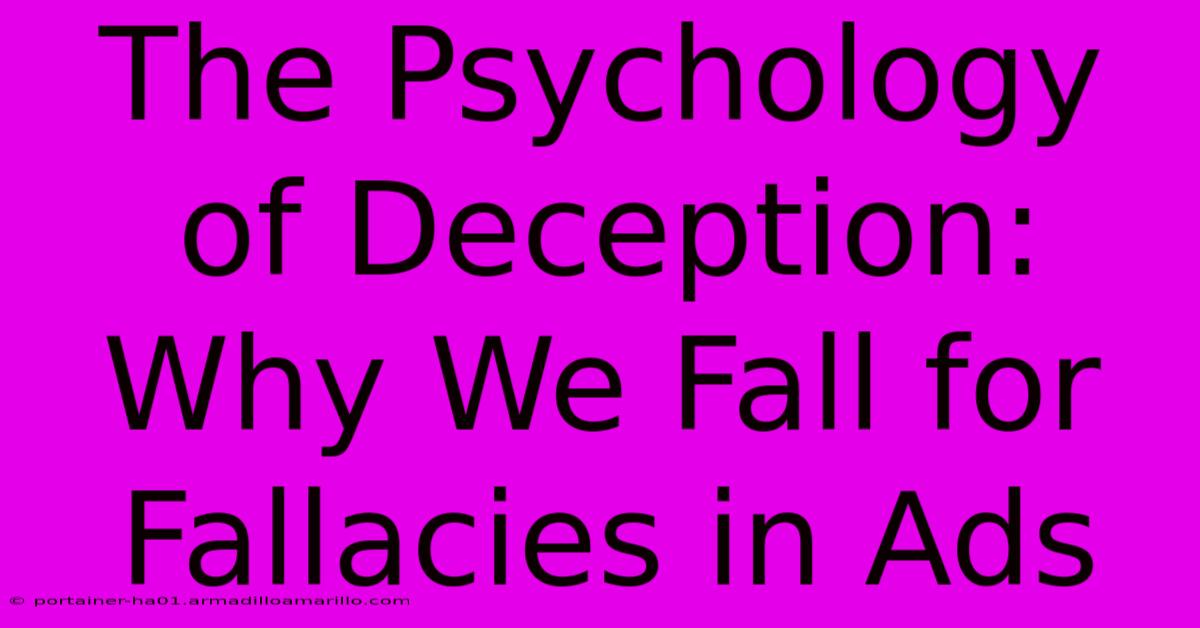The Psychology Of Deception: Why We Fall For Fallacies In Ads

Table of Contents
The Psychology of Deception: Why We Fall for Fallacies in Ads
Advertising is a powerful force shaping our desires and influencing our purchasing decisions. But how effective are these persuasive techniques? Often, it's not through rational argument, but by exploiting the quirks of human psychology. Understanding the psychology of deception in advertising is key to becoming a more discerning consumer and to creating more ethical marketing strategies.
Understanding the Cognitive Biases at Play
Our brains are not perfectly logical processors of information. Cognitive biases—systematic errors in thinking—make us vulnerable to advertising's manipulative tactics. Here are some key biases advertisers exploit:
1. Confirmation Bias:
We tend to favor information confirming our existing beliefs and ignore contradictory evidence. Advertisers leverage this by crafting messages aligning with our pre-existing values or aspirations. For example, an eco-conscious brand might highlight its sustainable practices, appealing to consumers who already prioritize environmental responsibility, while downplaying potentially negative aspects.
2. Anchoring Bias:
Our initial exposure to information strongly influences our subsequent judgments. Advertisers use this by presenting a high initial price (the "anchor") before revealing a seemingly discounted price, making the offer appear more attractive than it actually is.
3. Availability Heuristic:
We overestimate the likelihood of events easily recalled, often due to vivid imagery or emotional impact. Ads employing emotionally charged scenes or memorable jingles exploit this bias, making the product more memorable and seemingly more desirable.
4. Bandwagon Effect:
We're more likely to adopt beliefs and behaviors if we perceive them as popular. Advertisers utilize this by highlighting the popularity of their product, showing large numbers of satisfied customers, or emphasizing "best-selling" status.
5. Halo Effect:
Our positive impression of one aspect of something influences our perception of other aspects. A celebrity endorsement, for example, leverages the halo effect: We transfer positive feelings towards the celebrity onto the product they're promoting.
Common Fallacies in Advertising
Beyond cognitive biases, advertisers often employ logical fallacies to persuade. These are flaws in reasoning that undermine the validity of an argument:
1. Appeal to Emotion:
Instead of providing logical reasons to buy a product, ads often focus on evoking emotions like fear, joy, or nostalgia. A car commercial showing a happy family on a scenic road trip is an example of this.
2. False Dilemma:
Presenting only two options when more exist limits our choices. "Choose X or be left behind" is a classic example. This restricts critical thinking and encourages impulsive decision-making.
3. Appeal to Authority:
Using a celebrity or expert endorsement without sufficient evidence of their actual expertise. While a doctor might endorse a toothpaste, their expertise in dentistry doesn't necessarily translate to the efficacy of the product.
4. Red Herring:
Distracting from the main issue by introducing irrelevant information. An advertisement might boast about a company's charitable work to divert attention from the poor quality of its products.
Becoming a More Discerning Consumer
To protect yourself from deceptive advertising, cultivate critical thinking skills:
- Question the claims: Don't accept advertising messages at face value. Investigate the evidence supporting claims made in the advertisement.
- Identify biases: Recognize how your own biases might make you susceptible to manipulation.
- Look for evidence: Seek independent reviews and comparisons before making a purchasing decision.
- Be aware of logical fallacies: Learn to identify common fallacies used in advertising.
- Compare prices and features: Don't let emotional appeals or clever marketing overshadow the value proposition.
By understanding the psychology behind deceptive advertising, we can become more discerning consumers, making informed decisions based on reason rather than manipulation. This knowledge empowers us to navigate the complex world of marketing and make choices that truly align with our needs and values.

Thank you for visiting our website wich cover about The Psychology Of Deception: Why We Fall For Fallacies In Ads. We hope the information provided has been useful to you. Feel free to contact us if you have any questions or need further assistance. See you next time and dont miss to bookmark.
Featured Posts
-
The Astronomical Nil Deal That Will Elevate Your Star Power
Feb 07, 2025
-
Loves Sweetest Messenger Unveiling The Ultimate Valentines Day Valentine Cards
Feb 07, 2025
-
Hilarious Handles The Funniest College Football Player Names You Ll Ever Hear
Feb 07, 2025
-
Productivity Unleashed Automate Your Image Resolutions With Automator
Feb 07, 2025
-
Brace Yourself The Ultimate Bizarro List Of Footballer Names That Will Blow Your Cleats Off
Feb 07, 2025
